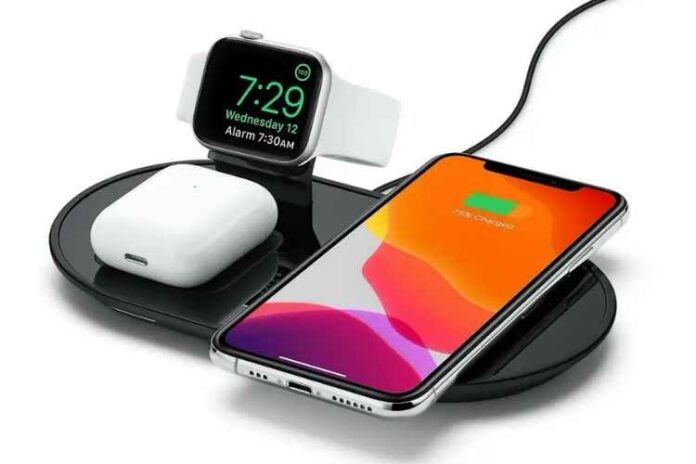Mobile batteries don’t last long, so charging cables that break after a few months might be inconvenient.In this blog we are going to tell you about Wireless Charging, So read this blog carefully to get the complete information.
Wireless charging is a useful option because it can be set and forgotten. But exactly how does it work?
While wireless charging may appear to be a recent development, its origins may be traced back more than a century to Nikola Tesla, a legendary Serbian-American inventor.
We’ll go through how wireless charging operates and which chargers are the finest in this tutorial.
What is the process of wireless charging?
Nikola Tesla succeeded in real electronics through the air in the late 1800s.
To power light bulbs at his New York City laboratory, he used a mechanism called reverberant coupling, which works by establishing a magnetic field between a transmitter (which emits electricity) and a receiver (which receives the electricity).
He patented the Tesla coil a few years later, which was a tower with a coil at the top that fired electrical bolts.
Tesla had much greater plans for a wireless power infrastructure, but they never came to fruition.
Inductive charging for smartphones follows the same basic principle as wireless charging for smartphones.
An electromagnetic coil, such as the induction coil in a charging base, generates a magnetic field and functions as an antenna for transmitting an energy field. The energy is received and harvested by a second smaller coil in the phone, or its electronics convert it back to useful energy for the battery.
Wireless charging has come a long way in recent years: charging speeds have improved, and many designers have standardised their technology under the Qi standard, allowing items to function with a wide range of smartphone brands.
Wireless charging technology isn’t just for phones; it may also be used to recharge medical implants like pacemakers.
RELATED – What Are The Popular Test Automation Tools For Functional Testing?
Wireless charging’s disadvantages
There are certain disadvantages to wireless charging. Although wired charging is faster and more effective, the farther the receiver is from the transmitter, the less power it receives from a magnetic field.
Phones consume so much energy that charging distances are measured in millimeters.
The larger the coil, according to Josiah Hester, an assistant professor of Computer Engineering at Northwestern University in Chicago, the more energy it can send out, but that would be inefficient. The center of the field is the most powerful.
He responded, “This field drops off fairly rapidly.” “After two millimeters, five centimeters, it still has some energy. At ten, it’s as if nothing has happened. You could definitely hold a coil the size of a desktop a foot above the desk, but you’d have to use a lot of power.
That is, in general, the major flaw with wireless charging. The goal of the study is to improve charging efficiency and enable our phones to be energy efficient. “
While this limits wireless charging for phones that consume a lot of electricity, it isn’t as difficult for smaller devices like RFID tags that consume less power.
According to Hester, the frequency difference between the two is comparable to that of an African elephant and an ant.
“Wireless charging and computing energy efficiency are both improving, so we’re taking advantage of both at the same time,” he explained. “He could do a lot more if he had a wireless charger to charge his phone.”
In other words, while wireless chargers are currently lacking, they will improve year after year.
What to Look for in a Wireless Charger?
There are a variety of wireless chargers on the market, each with a different price and quality.
After evaluating approximately 40 of them, Business Insider contributor Simon Hill ranked a couple of his favorites.
According to Hill, the Moshi Otto Q ($39.95) is the finest overall charger. The charger features a stylish design that looks good on a counter or side table, and it charges quickly.
A sticky pad on the bottom prevents the item from slipping if it is accidently bumped.
The device also features a foreign-object detection feature, which means it will turn off if a piece of metal is placed between it and your device, protecting it from damage.
A fantastic, inexpensive option is the RAVPower Fast Wireless Charging Pad ($16.98). While it isn’t as attractive as the Moshi Otto Q, it still offers fast charging capabilities, foreign object recognition, and a non-slip rubber surface.
However, if you have a thick case or a PopSocket, this adapter may not be sufficient.
The most opulent alternative is the Bezalel Altair ($64.98), a standup charging stand rather than a charging mat.
The stand is made of heavy-duty aluminum and can leave your phone in portrait or landscape orientation.
The Bezalel Altair can charge through cases with a thickness of up to 5 mm, but it will not recognise foreign objects when charging.
Related: How To Create A Discord Channel On Desktop And Mobile






![MX Player Custom Codec [AC3, DTS, MLP, TrueHD, and more] MX Player Custom Codec](https://techmenza.com/wp-content/uploads/2021/10/MX-Player-Custom-Codec-100x70.jpg)


